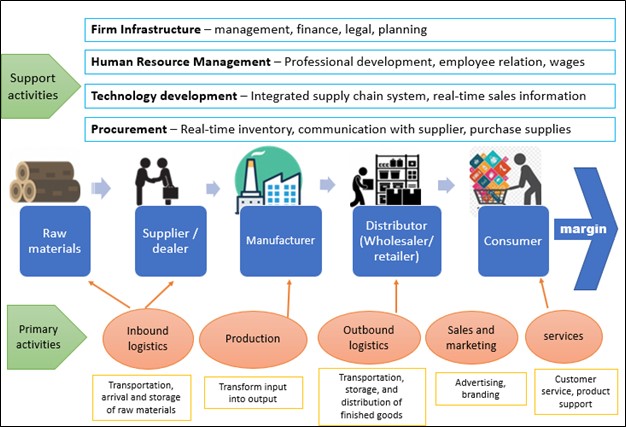Introduction
Malaysia is currently among the top producer and exporters of tropical wood products. However, due to increased competition, entrepreneurs, and small and medium enterprises (SMEs) must find ways to stay competitive in the market locally and globally. One of the ways to achieve competitive advantage is thru value chain analysis. This article provides a brief outline of the value chain analysis concept and its importance which can serve as useful information for the development of entrepreneurship and SMEs in the Malaysian wood-based sector.
What are Value Chain and Value Chain Analysis?
A value chain is a concept that describes the series of interrelated activities within a business that adds value to the product, starting with raw materials till the conversion into a valuable product or service to market. A value chain analysis (VCA) is a strategic tool to analyze each of the activities in a business’s value chain to increase the efficiency of the chain and to gain a competitive advantage.
The value chain concept was developed and popularized by Michael Porter in ‘Competitive Advantage: Creating and Sustaining Superior Performance’, published in 1985. Porter’s value chain analysis model (Porter, 1985) is a conceptual framework that enterprises can use to identify primary business activities that directly add value to the final product and support activities that add value indirectly. As can be seen in Figure 1, the primary activities involve inbound logistics to acquire the raw materials or inputs, production of the input into product or output, outbound logistics to distribute the output, and product sales and services. Effective management of the primary activities along the value chain can help businesses to gain a cost advantage (i.e., producing products at a lower cost). For supporting activities (i.e., firm infrastructure, human resource management, technology development, and procurement), although the activities are not directly involved in the evolution of the product, they provide underlying support for the primary activities and are an important source of achieving product or service differentiation advantage. By detecting the source of competitive advantage within each activity, Porter (1985) argued that it can offer the customer a level of value that exceeds the cost of the activities and ultimately produce a profit margin.
To date, various guidelines have been established to undertake value chain analysis. Nang'ole et al., (2011) provide a general guideline and manual for value chain analysis that can be used for the agriculture and forestry sector which was developed based on a review of thirty-two manuals and guidelines related to value chain analysis. The guidelines covered four broad stages of VCA namely: 1) appraisal of value chains and related information, 2) design of interventions to improve value chain performances, including technologies, institutional innovations, and policies, 3) Implementation of interventions, and 4) monitoring and evaluation.
Why Value Chain Analysis is Important?

Figure 1: Activities in the Value Chain (Adapted from Porter, 1985)
The increasing competition for offering the best price, product innovation, and customer loyalty are the primary needs for a business to strive. Hence, constantly examining the customers’ needs and requirements and then aligning the business’s operations efficiently and effectively to meet those needs through VCA will result in creating competitive advantages for the business (i.e., cost advantage or product differentiation advantage).
In the wood processing sector with many small and medium-sized enterprises, connection efficiency between value chain actors (e.g., forest owners, wood dealers, wood manufacturers, and end consumers) is very important to avoid the unintended additional cost (Schmithüsen et al., 2015). A recent study in operation research has shown that coordinated transportation can potentially reduce costs by up to 24% (Kogler et al., 2021). and effectively integrate the environmental and sustainability concerns into their value chain processes (Handfield, 1997). In Canada, many works are currently being done to upgrade its forestry value chain through various research and collaboration in different fields and areas to keep ahead of the competition which includes the use of high-performance technologies, optimization models to improve the process and use of wood fiber, decision support systems, and software for logging and transportation operation, wood sorting system, among others (Favreau, 2011) In addition, with the increasing importance of environmental and sustainability issues surrounding the forestry and wood sectors, entrepreneurs and small and medium enterprises need to constantly revaluate their operations and integrate the environmental and sustainability issues in their value chain activities.
Summary
This article provides a brief overview of the VCA concept and its importance. A VCA is an analytical tool that helps businesses to add value to each business activity along the value chain, right from the raw materials to end products or services. The analysis can help a business to achieve a competitive advantage and hence increase profitability. The VCA offers an excellent opportunity for Malaysian wood-based entrepreneurs and SMEs to develop a new business model and stand out among the global competition.
References
Favreau, F (2011). Value chain advantages. Canadian Forest Industries. Available at https:// www.woodbusiness.ca/value-chain-advantages-134/
Kogler, C., Schimpfhuber, S., Eichberger, C., & Rauch, P. (2021). Benchmarking procurement cost saving strategies for wood supply chains. Forests, 12(8), 1086.
Nang'ole, E., Mithöfer, D., & Franzel, S. (2011). Review of guidelines and manuals for value chain analysis for agricultural and forest products (pp. 1-30). Nairobi: World Agroforestry Centre.
Porter, M. E. (1985). Competitive advantage: Creating and sustaining superior performance. New York: Free Press.
Handfield, R. B., Walton, S. V., Seegers, L. K., & Melnyk, S. A. (1997). Green value chain practices in the furniture industry. Journal of Operations Management, 15(4), 293-315.
Schmithüsen, F., Kaiser, B., Schmidhauser, A., Mellinghoff, S., Perchthaler, K., & Kammerhofer, A. (2015). Entrepreneurship and management in forestry and wood processing: principles of business economics and management processes. Routledge.
Tarikh Input: 28/07/2022 | Kemaskini: 28/07/2022 | masridien
PERKONGSIAN MEDIA











 Figure 1: Activities in the Value Chain (Adapted from Porter, 1985)
Figure 1: Activities in the Value Chain (Adapted from Porter, 1985)
















